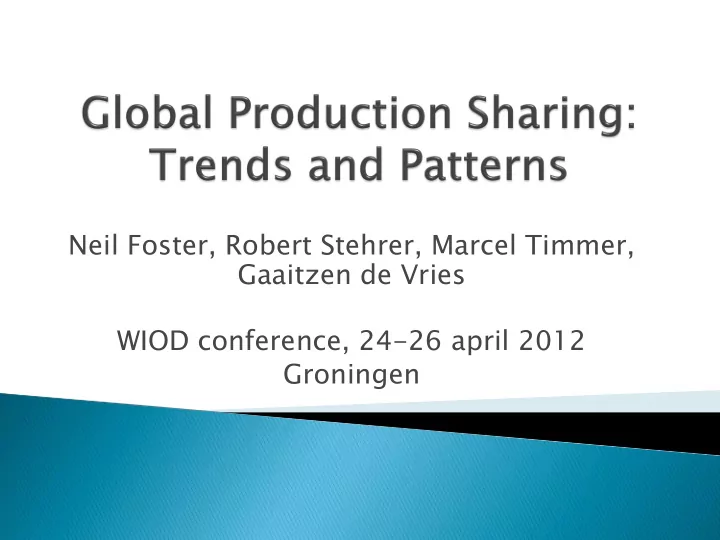

Neil Foster, Robert Stehrer, Marcel Timmer, Gaaitzen de Vries WIOD conference, 24-26 april 2012 Groningen
Local and global value chains (1 st & 2 nd unbundling) ◦ From made in [country] to: Made in the World Trade statistics are revealing ◦ Growth in trade versus growth in GDP ◦ Most trade is in intermediates nowadays Theory ◦ Trade in Activities (Feenstra and Hanson, 1996; Grossman and Rossi-Hansberg, 2008) Why? ◦ Information and Communication Technology ◦ Declining trade barriers, regional agreements ◦ Opening up of China and India
Measures global production sharing: ◦ Over time, from 1995-2009 ◦ Viz. GTAP, relevant improvements in the WIODatabase for measuring vertical specialization ◦ Extends production sharing measures to distinguish production factors Finds: ◦ Increasing vertical specialization Trend is robust to a host of controls, such as regional trade agreements and levels of economic development ◦ Regional shifts in foreign earnings ◦ Positive relation between GDP per capita and skill content contribution in value chains
International production fragmentation requires new measures of international trade (WTO, OECD, DGTrade) Analysis based on gross export and gross import data leads to controversial conclusions (e.g. Rodrik, 2006 vs Krugman, 2008) Recently, trade economists have started to measure the export of value added (e.g. Trefler and Zhu, 2010; Johnson and Noguera, 2012; Bems et al., 2011) ◦ Definit initio ion: the amount of value added produced in a given source country that is ultimately embodied in final goods absorbed abroad
Define number of countries C, industries S and Factors F A = Intermediate input coefficients (CSxCS) Total inputs required per unit of final demand is given by L = (I-A) -1 Where L is the Leontief inverse, which is a matrix indicating the output used both directly and indirectly to produce final goods
To measure the output contribution of countries in international production sharing (Johnson and Noguera, 2012): va_ va_ex exp = diag(r) r) (I –A) -1 c j where r is the ratio of value added to output for each sector in each country, and c j is the vector of final demand for country j Extension to production factors from shares in value added
Time series analysis based on national accounts data Intermediate use is broken down into domestic and foreign origin using detailed trade statistics A standardised database of bilateral services flows Socio-economic accounts for large developing countries, such as China and India
-0.05 0.00 0.05 0.10 0.15 0.20 0.25 0.30 0.35 0.40 0.45 0.50 European Union 27 United States Rest of the World Japan China Germany France 1995 value added export to GDP ratio United Kingdom Italy Spain Russia Brazil Canada India Mexico Australia South Korea change from 1995 to 2008 Netherlands Turkey Indonesia Poland Belgium Sweden Taiwan Austria Greece Denmark Finland Ireland Portugal
13 25 13 47 1995 3 1. EU27 18 10 14 52 2008 6 12 23 12 44 1995 6 3 2. EU15 10 16 12 47 2008 6 9 59 10 19 1995 4 7 1 3. EU12 54 26 2008 3 5 3 9 18 28 39 1995 1 7 6 4. East As 16 18 19 10 35 2008 2 24 16 48 1995 1 2 9 5. US 21 12 49 2008 2 8 8 22 23 25 23 1995 1 5 6. China 21 11 20 10 36 2008 2 36 13 23 22 1995 4 2 7. BRIIMT 28 22 31 2008 5 7 7 32 21 33 1995 1 4 9 8. Rest 30 14 29 12 12 2008 3 0 20 40 60 80 100 Percentage EU15 EU12 East Asia US China BRIIMT Rest
.4 .3 Low-skilled VAX .2 .2 .1 .15 High-skilled VAX 0 .1 0 10000 20000 30000 GDP per capita .05 0 0 10000 20000 30000 GDP per capita
New measures of trade are needed for the modern international economy This paper extends the export of value added in time and across production factors Main conclusions: Increasing vertical specialization 1. Regional shifts in foreign earnings 2. Positive relation between GDP per capita 3. and skill content contribution in value chains Thanks g.j.de.vries@rug.nl
Recommend
More recommend